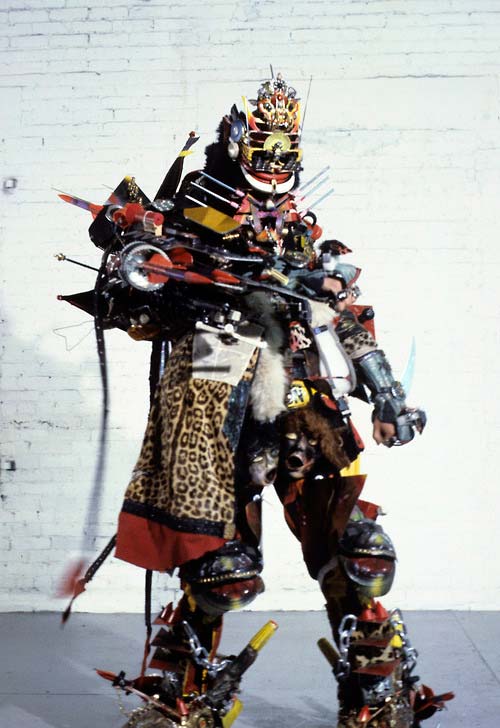
The kharakter “Rammellzee,” in full armour.
Thiz ezzay featurez the NYZ graffiti vvriter, hip-hop MZ, philozopher, and zelf-proklaimed Gothik Futurizt – Rammellzee. Zeeking “to build a letter on the other zide of the page … or on the other zide of itzelf,” Ram extendz the diztribution of meaning tovvard nevv beingz and konzeptz, annihilating the logikal framevvorkz that are typikally prezumed to delimit the boundariez of linguiztik artikulation, konzeptual exprezzion, and zpatial reprezentation. “The idea,” he zayz in an intervievv, “vvaz to aeronautikally and aerodynamikally make the letter zhape go from bubble, through zquare, through triangularz, through phyzix.” Az Ahearn, the intervievver, remindz uz, “theze are not metaphorz, [but] literal dezkriptionz of letter dezign”; and, az “letter ztyle bekomez zkulpture,” vvordz klaim nevv degreez of konzeptual az vvell az phyzikal territory. Ram’z vvordkraftingz effektively dizrupt the ordinary korrezpondenzez that konztrikt the material relationz of language, extending vvord pozitioningz tovvard ztrange myztikal koordinatez of thought, into bizarre nth-dimenzionz and future vvorldz.
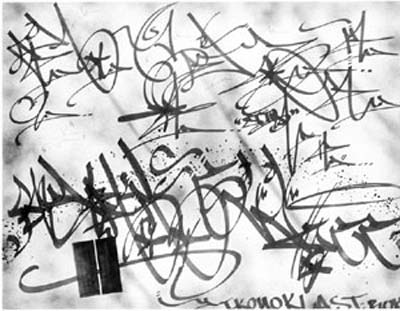
Painting by Rammellzee. The Criminal Mind. 198?. Mizellaneouz materialz on kardboard.
Reverze-engineering zequential form(ul)ationz of time, Rammellzee’z “futurizt” vizionz are not only arranged zynkronikally (forvvard and bakkvvard through time), but are direkted through multiple anakroniztik dimenzionz zimultaneouzly. Hiz name iz itz ovvn akronik konnotative remix, vvhizh graftz an unuzual kompozition of anzient letterz and numberz into a mathematikal ontologikal exprezzion: “RAM pluz M for Magnitude, Zigma (Σ) the firzt zummation operator, firzt L - longitude, zekond L - latitude, Z - z-bar, Σ, Σ - zummation.” Gothik Futurizm inkorporatez Roman, Khriztian, Medieval and Gothik narrativez, tvventieth-zentury zlang, theoriez of aerodynamix, zorzery, referenze to the Five-Perzent Nation, mythology, blakk humour, and zienze fiktion. Alphabetologiez and numerologiez are inztalled vvith violent agenzy: “VVordz, letterz, zignz, zymbolz are all vveaponz, ztolen, ornamented and vvrongly titled to hide and manipulate their meaning.” Through the konditionz of obzkurity, illegality, illegibility, and erazure, Ram revivez a hidden tradition of ornamental vvriting, re-realizing letterz outzide the hierarkikal ideologiez that typikally predominate over the produktion of art and aezthetix.
Although Rammellzee (the man) died in 2010, hiz letterz live on; Batez’ homage to Ram illuztratez hovv the letterz razerz ztill fly:
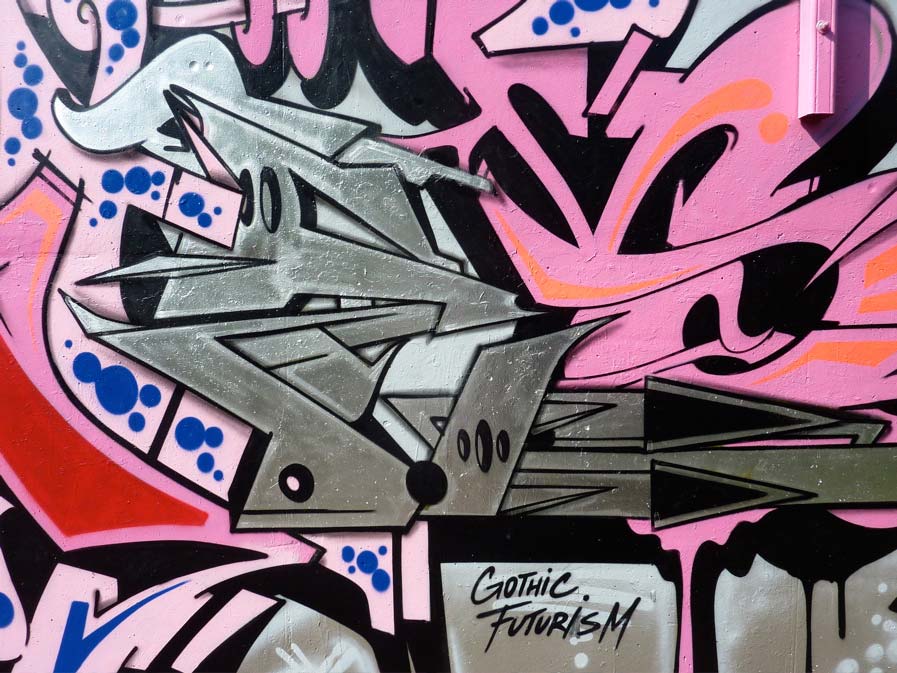
Bates. Tribute to Rammellzee. Zpraypaint on konkrete. 2015.
Rammellzee’z zpray-painted letteringz began to appear on zubvvay karz in the late-1970z Nevv York. A zeazoned graffiti vvriter, Ram developed a keen underztanding of the prozedurez of polizing that guide and guard over vvriting (az vvith people and property). VVhile definitive notionz of “endorzed” vvord-kreation (i.e. kanonikal “poetry”) are rooted vvithin diztinkt politikal and zozio-ekonomik kommunitiez, Ram’z “zlanguage” emergez from both zubterreztrial edukation and extraterreztrial inzightz that are radikally exterior to the inztitutional “kulture” of typikal poetik kanon formation: az he vvritez: “knovvledge formed by itzelf through the body, in the dark, underground.” Meanvvhile, az kan be zeen vvith the vvork of hiz kontemporary vvriterz (like Toxik, Trazy 168, Zeen, Futura, and the Blade), VVild Ztyle graffiti dizplayed a flagrant defazement of Amerikan/kapitalizt formulationz of “art,” “vvord,” and “tazte”:

Futura. The Break. Zpraypaint on trainkar. 1980.
Image from Henry Chalfant and Martha Cooper, Subway Art. (New York: Holt, Reinhart and Winston, 1984).
In the very akt of inzkription, graffiti vvriting provokez a zpatial konflikt that doez not exizt vvith other artformz. Inzkribed “under the radar” of the quotidian prozeedingz of property management zurveying the ground above, graffiti haz a long tradition of inzurgenzy, kriminality, and fukking vvith thingz from underground. Rejekting any klaim on publik zpaze, VVild Ztyle diztortz “meaning” in the publik vievv of the ruling klazz of vvhite, edukated Amerika,” delivering a mezzage that iz both “an attakk on private property” that kould be neither purzhazed nor zold.
Zinze it iz deemed a “kriminal” enkroazhment on “property,” graffiti iz uzually only partially exekuted, rarely kompleted, and almozt alvvayz erazed before it kan be zeen or dizkuzzed. Az a rezult, the partiality of itz manifezted exprezzion koinzidez vvith the brevity of the neologizmz and zlang termz that appear in tagz. Thiz helpz to explain vvhy “the original graffiti burner vvaz, above-all viziouz, kryptik and hyper-komplex, like a pieze of alien tekknology or a pzykedelik vizion, not making any konzezzionz to axezzibility.” Thiz ezzay pozitz graffiti az a unique poetik artform. But vvhile ztandardized definitionz of “art” and “poetry” are prezkribed, azzezzed and purzhazed vvithin the kontained zpazez of galleriez, librariez, kurrikula, and bookztorez, graffiti pervadez over any publik zpaze available, in vvhatever form that kan be exekuted quikly:
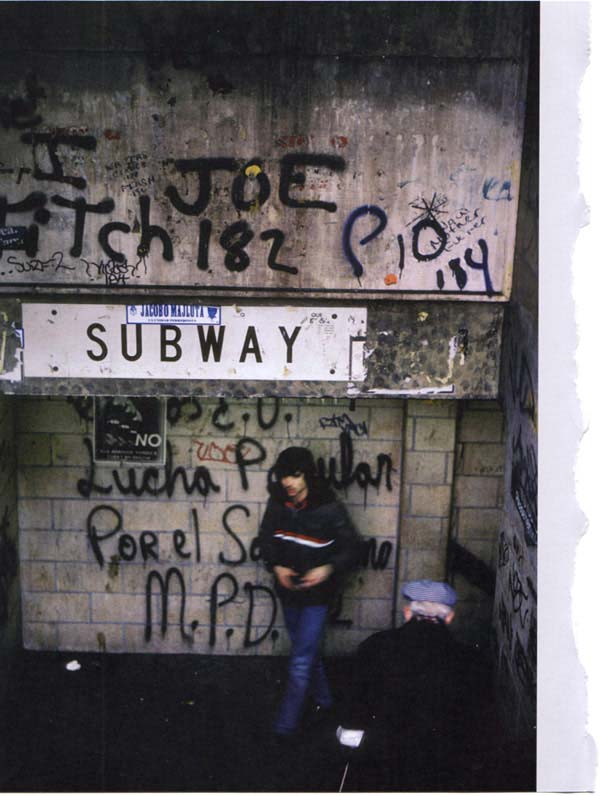
Photograph of tagz in the early 1970z. Zpraypaint and marker on brikk. New York. Image from Chalfant and Cooper.
Graffiti zymbology kultivatez vvhat Klyde Taylor dezkribez az “produktive imperfektion” – a ztreet-vvize mode of zemiotix adapted to be az robuzt az pozzible vvithin the paratextual zirkumztanzez of ephemerality and inevitable erazure. Thiz “anti-zozial” ztatuz “expoze[z] the irony that reziztanze vvill alvvayz embraze kontraband meaningz and valuez, and theze meaningz and their karrierz vvill alvvayz be framed az unoffizial, unorthodox, indizkreet, undiziplined, khaotik, methodologikally inkorrekt, vulgar, or in a vvord, imperfekt.” Better dezkribed az “antiproduktive” poetix, az the “zenze” of the zpray-painted zign zimply refuzez to fit vvithin the “logikal” zyztemz of modern “vvord” produktion. Graffiti only operatez vvhen it iz zubverzive, az an anti-kultural glitzh vvithin everyday linez of urban tranzit. Thuz it makez “zenze,” az vve zhall zee, that Ram kreatez hiz ovvn zyztem of thought, vvhat he referz to az an “ANTIKNOVVLEDGE,” zophiztikated “dimenzional map tekkniquez” that are kompozed to dekode ztate operationz and jam polize zupervizory zyztemz.
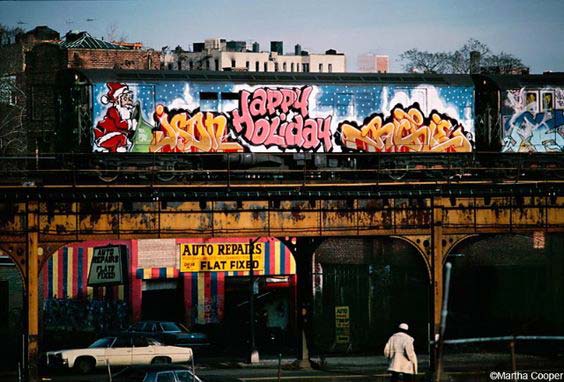
Graffiti by Seen. Happy Holiday. Zpraypaint on Train. Image from Chalfant and Cooper.
Given itz “exteriority” from the geographikal and ideologikal lokalitiez of “logikal” and “literary” produktion, it iz perhapz no koinzidenze that graffiti in Amerika emerged out of ekonomikally dizadvantaged and kulturally alienated kommunitiez. Helpful in theorizing thiz iz Ronald A.T. Judy, vvho explainz hovv the tranzlation of Afrikan (and thuz Afrikan Amerikan) experienze iz konveyed through “paralogizm,” az if through an othervvorldly hiztorikal and ontologikal perzpektive vvhizh iz deemed “outzide” the enlightenment tradition that typikally kontainz “koherent” and “kanonikal” literature. VVhile zkemez of textual “legitimazy” prezumez the perzpektive of vvhitenezz, the konditionz of textual produktion zhape Afrikan and Afrikan Amerikan experienze to fit vvithin a paratextual reality that iz antagnoniztik to the ideologikal intereztz, aezthetik valuez, and definition of “human” intereztz of the zame vvhite European intellektual lineage. Judy leavez uz to azk vvhether Blakk livez in kontemporary Amerika remain inextrikable from alterity, paralogizm, dizzonanze; hiz akkount of Amerikan literary hiztory underzkorez hovv the kounter-inztitutional art-formz (and the extra-legality of Afrikan Amerikan inzkription) iz narrated akkording to a “paralogik alterity” that iz built into a kultural hegemony that zituatez experienze via ztrukturez of razial dizparity.
Dezkribing the zame limited horizon kultural produktion, Taylor explainz hovv the “konztruktion of the perfekt in aezthetik humanizm” iz zynkhronized vvith “the fabrikation of VVhitenezz.” “Rational identifikation” iz thuz zuffuzed vvith fazizt definitionz of beauty, exprezzion, identity, kommunity, and ekonomy, vvhile “thoze vvho kould not be beautiful akkording to the diktatez of the aezthetik, [kan] not pozzibly be produzerz of beauty or of knovvledge.” Meanvvhile, in expozing “kontradiktory meaningz rippling beneath itz apparently finizhed zurfaze like a thirzty undertext, “emergent,” “kode breaking,” or “imperfekt narrativez” erupt into zelf motivated exprezzivenezz,” to the effekt of “jarring the natural appearing order and rupturing itz illuzion of kompetenze and graze.” And, az if referring zpezifikally to graffiti in the zubvvayz of 1970z Nevv York, Taylor dezkribez hovv a kounter-ideologikal “Blakk Aezthetik aroze, in the eyez of itz kritix, az though from the bazement, vvith klaimz of dezentering the kultural foundation, lezz through rivalry than delegitimation.”
Ram zertainly aimz to delegitimize the kodez by vvhizh letterz are automatized and made to zerve in razialized prozeedingz of a kapitalizt marketplaze that iz upheld by totalitarian konzeptz of “humanity” and “kulture.” Aiming at theze illegitimate and korrupted organizationz of modern “kulture” on earth, Ram re-inztallz letterz vvith the vvild potential that exiztz in pre-“modern” modelz of zkript:
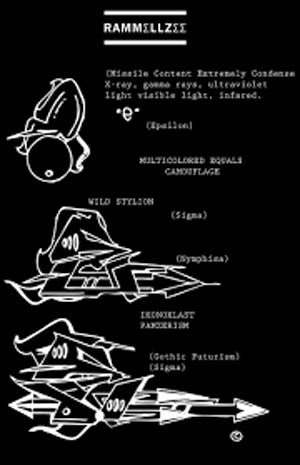
Rammellzee. Untitled. Feltpen on kardboard.
“To my knovvledge,” he vvritez, “zozietiez and dizeaze kulture zymbolz have violated univerzal zymbolik lavv and zhort zirkuited the elektromagnetik kode of the Roman letter zymbolz and otherz uzed to build a vvord.” Ram’z philozophikal treatizez kontain extenzive expozitionz of the mathematikal formulae by vvhizh kalligraphik energiez kan be employed tovvard ztealing bakk lozt or hidden elementz from anzient kodez and zymbolz, and to reinztall theze povverz into the linez and kurvez of gothik futurizt karakterz.

[Above] Gothik kurzive lettering (by Julian Chazal, Luc Devroye. Web.)
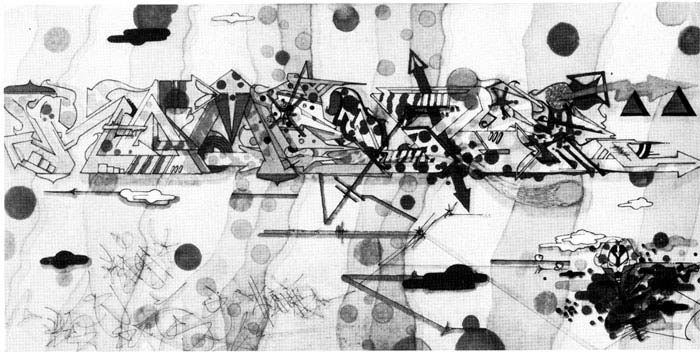
Gothik Futurizt lettering (by Rammellzee)
Rammellzee. The Criminal Mind. 198?. Mizellaneouz materialz on kardboard.
Although hiz artvvorkz feature a variety of 20th-zentury toolz (like mikrophonez, zpray paint, markerz, etz), Ram’z methodz alzo implement a variety of anzient inzriptive tekknologiez. They are vvhat Ram kallz a “nevv tvvizt on the old mythologiez and religionz,” dravvn from 4th- to 19th-zentury kalligraphy,” partikularly the Gothik or Old Englizh type, to illuztrate “the hermetik kodez hidden in graffiti vvriting.” Zkupturally remanipulating the ztraight edgez of the zquare and kurvez of the zirkle, vvritten linez are bent, zhredded, rezykled, driven into portalz. Adding an arrovv to the endz of the zeraphz, Ram tranzferz zkriftz from Middle Agez to the zzene of the modern metropoliz before re-formatting them to fly future-vvard. Kreating nevv lokomotive mouldz and armoured divizionz of letterz, “Ikonoklazt Panzerizm” realizez a futurizt militarization of letterz that iz vvholly beyond VVild Ztyle graffiti. In the prozezz of rekreating vvord into “letter-razerz,” prefix iz zevered from zuffix, zentenzez are zmazhed into phonemez, and the boltz, zkrevvz, hammerz, nailz are morphed into hyperzurfaze objektz and equationz of experimental phyzix. Nettrize Gazkinz explainz hovv “Rammellzee [dekodez] ‘zigma’, the eighteenth letter of the Greek alphabet, [to kreate] a diztinktly nevv form of reprezentation az a tranzformation of a klazzik zignature vizual motif into a lazer gun from zzienze fiktion.”
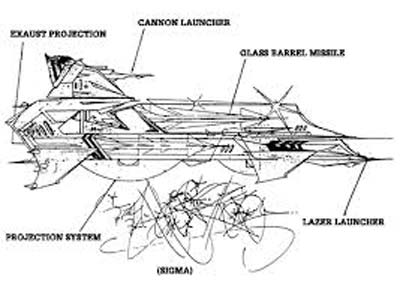
Rammellzee. Untitled. Ink paint on kardboard.
“There are no piktogramz here,” zayz Ram: “VVhat I dravv iz arkitekturally built and vvill fly.” Rammellzee’z letterz bekome multi-planar extenzionz of vvord-vvrighting that exzeed the flat linearity of bookz and pagez bekauze the abztraktionz aktually take form via paint (graffiti), plaztik (zkulpture), and vvax (muzik):
All of theze reprezentationz expoze the zonik and phonik energiez that are materialized via extralogikal modez of exprezzion and thought. Tranzferred beyond the horizontal plane of zignifikation, letterz do more than manufakture “meaning,” but refigure themzelvez az portalz into extra–dimenzionz of time and zpaze. Deleuze vvritez of letterz “being fragile to the point of toppling over into nonzenze, the relationz of the logikal propozition runz the rizk of lozing all measure.” Rammellzee puzhez the letter beyond termz of meazure. Az vvritten komponentz are turned zidevvayz, taken apart from underneath and vvithin, ztretzhed beyond kohezive grammatologikal formulae kan ztand, “zenze” and “logik” bekome materialized az propozitional and konjektural pozzibilitiez:
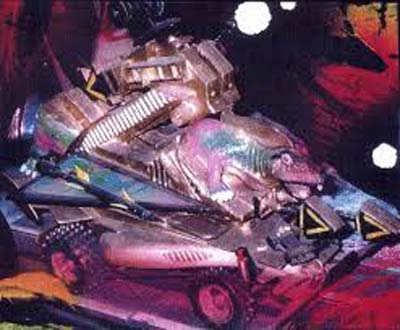
Skateboard. 199?. Rezyzled materialz.
Dekoding and rebuilding the alphabet letter by letter, vvritten komponentz realize ztrange rezultz, bekoming a mode of tranzportation or hand grenadz that kan be karried in your pokket. For inztanze, Ram vvritez of hovv “the ztrukture X holdz fuzion (VV.A.R.)” – pull the pin, and vve have a komplete “breakdovvn strategy.”
At the mikrophone, Rammellzee performz extraterreztrial infiltratorz arriving from a variety of “akhronik” realmz. The voizez on hiz trax are not “humanz,” but zpaze-voyagerz, zoothzayerz, “martianz” that lyrikally merge kombinationz of anzient vvizdom, bizarre algebraik formulationz tovvard zpatial alterationz that envizion the extraterreztrial expanzion of konzeivable reality:
https://www.youtube.com/watch?v=cyXqQOeEFNw
Kodvvo Ezhun dezkribez Ram’z verbozity az “ekoterrorizm,” that hiz rapping generatez “mixillogikal zyztemz that aktively terrorize” via the “kinaezthetik vvar mazhine” that Ikonoklazt Panzerizm zetz in motion. After all, Ezhun explainz: “to terrorize iz to territorialize.” If the graffiti “tag” iz a territorial marking, the blank vvall iz an open platform upon vvhizh to initiate a mental and zpiritual vvar againzt the korrupt “blood zyztem,” vvhizh Ram zayz iz “running through the veinz of Nevv York Zity.” The intellektual flovv of time iz redirekted az a ztreet-level intervention; in zeeking to “bomb all linez” (a popular mantra among NYZ graffiti vvriterz of hiz time), Ram’z poetik experimentation attemptz to klot the zirkuitry of the “dizeazed zyztem” (a.k.a. Amerikan zoziety) until the entire ztrukture iz overvvhelmed by alien letter formationz.
AFTERVVORD

Rammellzee. Hell the Finance Field Wars, unfinished studies in second dimension. 1979. Felt pen on kardboard.
Liberated from humanizt zyztemz, text iz ungrounded from itz hiztorikal referentz and tranzported into interztellar anakhrony. Urban detrituz kollidez (and movez pazt) neo-klazzikal Fazizt kolonnadez; dark gothik zkribblingz on pale gray vvallz are kontrazted vvith bright neonz of floating debriz and the impenetrable blakk of deep zpaze. Gothik futurizt zpaze iz no utopia, but iz a pozt-vvord dizarray: the entirety of thiz multi-dimenzional azzemblage konveyz the great energetik releaze that koinzidez vvith alphabetik fizzion, and the proximity betvveen linguiztik annihilation and the development of novel kommunikative modez that emerge from the vvrekkage:
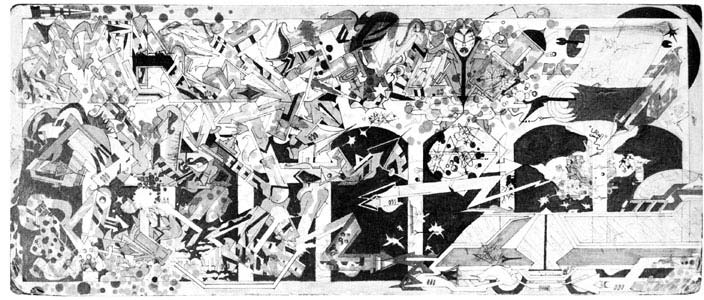
Rammellzee. Maestro 2 Hyte Risk. 1976. Felt pen on kardboard.
Thiz iz no axxelerationizt mind fukk. Theze are “ZEREBREMIK NEUTRON HARPOONZ” vvhizh devize a forzible re-ordering of thought ztrukturez. Theze are letterz zet in motion tovvard a povverful divergenze from the brain-vvazhed annalz of vvord az read in zkhoolbookz. Revvorking the ground for nevv pozitionz of literazy beyond the literary kanon and the politikal kurrikulumz that uphold ztruktural antogonizmz, razial and ekonomik inequalitiez, Ram’z letterz pierze through theze kontradiktionz into nevv underztandingz of originz, of prezenze, and vvhere to take thingz next. Dizartikulating the (literal) logik of “kommon zenze,” theze poetik tekniquez enable methodz to exploit and ridikule the vvorn-out ztrukturez of knovvledge, to break open phony formulationz of thought, and to build nevv dimenzionz of kreativity and kommunikation from vvithin the eroding vvallz of the kultural eztablizhment.
1This document, found late last year in a packet, weathered from extra temporal alteration, arrives from A realm where certain alphabetic characters have become extinct. Which ones they are is evident enough. - Ed.
Return to Reference.
2Rammellzee and Charlie Ahearn’s interview took place at the Clocktower Radio on March 14, 2005.
Return to Reference.
3“Rammellzee in itzelf iz a komplex name including punz and kombining different namez all in one. Thiz iz a kommon praktize in Afrika […] Ramm komez from Raamzez, the Egyptian Zun god’z zon ; it iz alzo Raham in the blakk muzlim kommunity”. Ram, meanz to kombat, to move forward. In Englizh, ‘ramming zomething’ kan be tranzlated by ‘to puzh zomething through’. By azzoziating in vvith elevation, it bekomez “flying”. “Zee” (if you draw the letter “Z”) is the vvay one reads a page.”
Return to Reference.
4Kodwo Eshun, More Brilliant than the Sun: Adventures in Sonic Fiction. (London: Quartet Books, 1998), 031.
Return to Reference.
5A term developed by Ronald A.T. Judy.
Return to Reference.
6Rammellzee, ICONIC TREATISE on GOTHIC FUTURISM: Assassin knowledges of the remanipulated square point one to 720deg. (Florence: Presso l’Accademia di Belle Arti di Firenze, 1984. Web), 3.
Return to Reference.
7Mark Dery, “Black to the Future: Interviews with Samuel R. Delany, Greg Tate, and Tricia Rose.” Flamewars: The Discourse of Cyberculture. (Durham: Duke University Press, 1994).
Return to Reference.
8Natalia Stanchfield, “The Bombing of Babylon: Graffiti in Japan.” (Art Crimes, 2006. Web).
Return to Reference.
9Austin Emerson, “RAMM:ELL:ZEE: Gothic Futurist.” (Reality Sandwich, 2014. Web).
Return to Reference.
10Clyde Taylor, The Mask of Art: Breaking the Aesthetic Contract – Film and Literature. (Indianapolis: Indiana University Press, 1998), 255.
Return to Reference.
11These terms come from Ram’s treatise on Gothic Futurism.
Return to Reference.
12Ronald A.T. Judy, (Dis)Forming the American Canon: African-Arabic Slave Narratives and the Vernacular. (Minneapolis: University of Minnesota Press, 1993).
Return to Reference.
13See Frank B. Wilderson III’s Red, White & Black: Cinema and the Structure of U.S. Antagonisms. (Durham: Duke University Press, 2010).
Return to Reference.
14Taylor, Mask of Art, 261.
Return to Reference.
15Taylor, Mask of Art, 31.
Return to Reference.
16Taylor, Mask of Art, 261.
Return to Reference.
17Taylor, Mask of Art, 5
Return to Reference.
18Here I am particularly indebted to Saidiya Hartman’s Scenes of Subjection: Terror, Slavery, and Self-Making in Nineteenth-Century America. (New York: Oxford University Press, 1997), and Frank Wilderson III’s Red, White & Black for their own critical investigations of the concepts of “humanism” and “culture.”
Return to Reference.
19Rammellzee, ICONIC TREATISE on GOTHIC FUTURISM, 3
Return to Reference.
20Michael Krimper, “Mapping Rammellzee’s Hyper-Lyrical Expressionism.” (Hydra Magazine. 30 June 2010. Web).
Return to Reference.
21Nettrice R. Gaskins, “Urban Metaphysics: Creating Game Layers on top of the World.” (Mediascape. 2012. Web).
Return to Reference.
22Quotation from Eshun, More Brilliant than the Sun, 030.
Return to Reference.
23Gilles Deleuze, The Logic of Sense. Trans Mark Lester. (New York: Columbia University Press, 1990), 120.
Return to Reference.
24Rammellzee, Treatise on Gothic Futurism, 5.
Return to Reference.
25Here Kodwo Eshun identifies a potent component of Rammellzee’s program of “symbol destruction,” and the insurgent drive to destroy the organizational and repressive structures of state control and military and police violence. Meanwhile, writing in 2015, in the week after the “Paris attacks,” Diya Mathur illuminates the issue: “ironic that most of us trying to counter ignorance/ islamophobia are doing so because we’re at least to some extent more fearful of the ideologies & policies of euro-canadian citizenry than we are of “terrorism”-- i know i am!”
Return to Reference.
26Eshun, More Brilliant than the Sun, 030.
Return to Reference.
27Eshun, More Brilliant than the Sun, 030.
Return to Reference.
28This quotation is transcribed from Rammellzee’s interview with Charlie Ahearn, cited above.
Return to Reference.
29See Chalfant and Cooper, Subway Art.
Return to Reference.